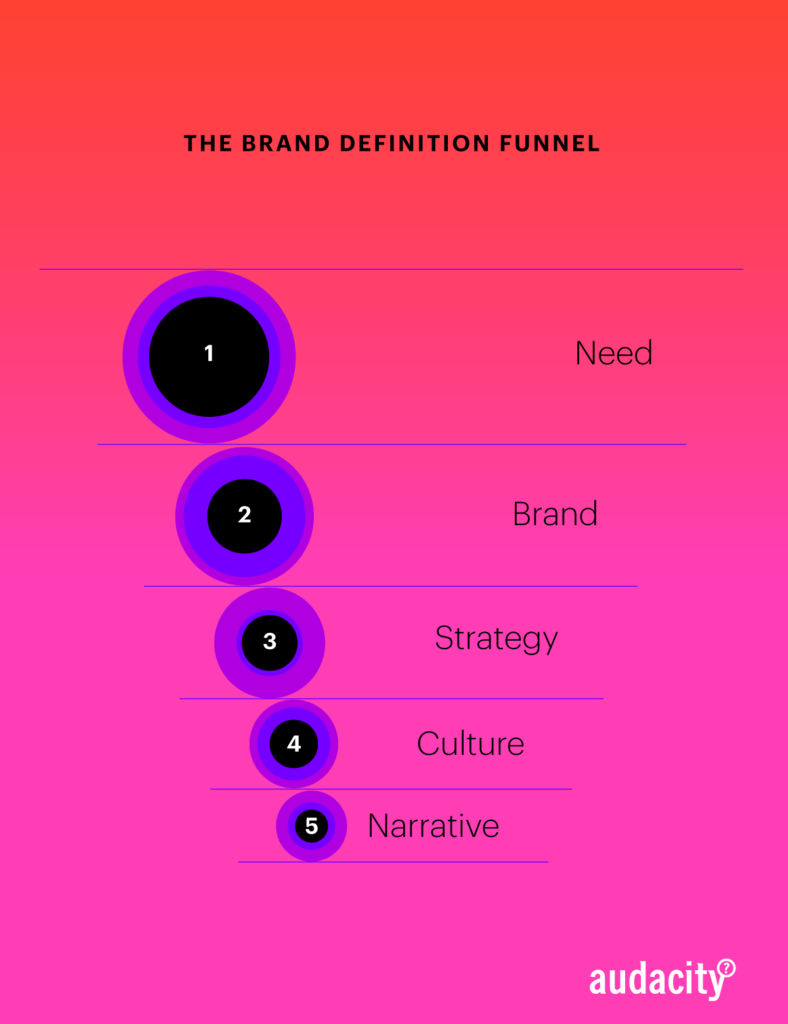Five major brand strategy decisions can help marketers and business owners quickly define the key connective elements of their wider brand definition. These crucial decisions provide a secure framework for then fully strategising successful brands.
The major brand strategy decisions you should focus on first
- The nature of the customer need you are looking to meet
- The type of brand you are creating
- The nature of the strategy you need to develop
- The type of culture such a brand will need
- The narrative you will need
Define your high level intentions before your projects
One of the criticisms we hear most often, especially with an established brand, is that people just want to “get on with it”. Facing the need to change direction, or at least examine it, the temptation is to prioritise tactical marketing decisions such as brand name selection, line extensions, becoming a private brand or brand sponsorship, and invest energy into getting them to work. It’s tempting to think that bringing these decisions to life is the brand strategy.
But the real key to making successful major brand strategy decisions is first to stop and establish a context and criteria for what it will take for the brand to succeed going forward from a business point of view. Our Brand Definition Funnel enables a multi-disciplinary team to broadly define how they intend to structure, support and market their brand, no matter whether the brand is new or an established brand.
The importance of pre-strategy in decision-making
We actually call these decisions the pre-strategy because they can set the scene for any deeper and more exploratory strategy work that may need to follow. The Brand Definition Funnel starts at the widest point, with how familiar and urgent the offer feels to customers, and narrows down to the specific type of story the brand should tell. The purpose here is not to focus on the detail. Each decision is just a word or two. Instead, it’s about ruling things in and out and setting out any parameters for deeper investigation.
Once you have made these decisions, level by level, you will be able to approach brand development and brand positioning and a myriad of tactical brand decisions from a more informed place. You have a snapshot of what you need, or a confirmation of what’s there already. Marketers can then focus on bringing each level alive, without losing sight of the context.
A decision funnel, not a sales funnel
Funnels are not an uncommon tool for marketers. However most brand funnel models are concentrated on customer decision making. The Brand Definition Funnel does quite a different job. It doesn’t reference the Awareness-Interest-Consideration-Decision stages of the sales funnel. Instead, it looks at forming a powerful preliminary understanding of what the brand represents.
It’s powerful because it provides a systematic way to filter the many variables within five major brand strategy decisions: need; strategy; culture; structure and story:
- 2 different types of customer need – on three levels
- 5 brand decisions – each with a range of variants
- 5 strategic choices
- 4 supporting culture options
- 3 ways of shaping a narrative

What does our Brand Definition Funnel deliver?
At first glance, it seems like a lot. It is. Together, these elements represent literally tens of thousands of ways of potentially configuring your brand’s wider identity. But by working through each level and filtering these options down to a much more manageable level, decisions become tighter, more focused and more likely to be aligned strategically.
Each element breaks down into more detail. For example, “needs” break down into recognised and unmet customer needs. Recognised customer needs then break down into high priority or low priority. From there, they divide again into little or high competitive activity. If your product or service offers something new to market, here’s How to identify and meet unmet customer needs.
Once you’ve defined the customer need, you can start to describe the type of brand you need to create, and then the type of strategy. Then the culture. Then the narrative.
Say your product category is meeting a recognised, high priority need with little competitive activity. Your strategy will probably focus on taking the high ground and proving your brand is what customers have been desperately looking for. That’s a very different pre-set than if you’re looking to introduce a product brand to a market that addresses a need customers don’t yet recognise and is therefore an unknown priority for them. There, your strategy will focus on establishing a desire that customers can relate to.
Contextual brand strategy decisions
We developed our Definition Funnel in response to the often heard complaint that everything about defining or confirming a brand strategy seemed to take so long. The model structure is not dissimilar to that of the Business Model Canvas which uses an inter-relational chart to evaluate the implications for developing business models.
Too many brand strategy projects start too broadly. Because no parameters have been defined, a strategy team must first go through and eliminate a full range of possibilities. That in turn influences the early stages of the brand strategy process. Initial conversations and interviews are broad-brush. A lot of people speak about a lot of things – because they can. And that quickly leads to a parade of possibilities, rather than a succinct evaluation of specific options.
Examining a retail brand intended to address a high-priority, recognised need on a global basis is very differently strategically than looking at a locally based B2B brand trying to build value in a low-priority market.
Seeing major brand strategy decisions as a whole
In many traditional brand strategy projects, even high level decisions are sequential. Companies don’t even start to consider the culture or the type of story they will tell until they have signed off the strategy. That often leads to new teams tackling the many ‘moving parts’ of the wider brand identity one after the other. Ongoing rebriefing can then lead to teams making decisions that make sense to them. However, those decisions don’t necessarily enable the branded ecosystem to work to capacity. If an earlier decision changes, everyone else must stop what they are doing until other decisions are retaken.
The purpose here is not to focus on the detail. Instead, it’s about ruling out incompatibilities and setting out the parameters for deeper investigation. Marketers can focus on defining each level, without losing sight of the context. They can then appoint specific teams to focus on working through the detail of each element. Those different teams can work on different elements simultaneously. For example, one team can concentrate on the logistics and challenges of building a regional brand. At the same time, another team can work out what it will mean to shift to a more tribal culture.
But with the Brand Definition Funnel, you have an agreed overview of what your brand strategy looks like based on the decisions you have made.
You can then appoint specific teams to focus on working through the detail of each element. Those different teams can work on strategic options for different elements simultaneously. For example, one team can concentrate on the logistics and challenges of building a regional brand. At the same time, another team can work out what it will mean to shift to a more tribal culture.
Achieve broad consensus on defining your brand’s competitiveness in hours
This funnel avoids the sandtraps of fully defining one thing before moving onto the next. The strategy process, for example, starts with many things taken off the table – meaning it is much more focused. Teams can canvass, discuss and agree the biggest decisions that govern a brand’s ability to compete, in hours rather than months. And the wider team understands the overall brand definition in-principle before any in-depth strategic work starts.
Having these discussions upfront not only increases buy-in, it also saves a great deal of time when it comes to evaluating the final strategy. Decision-makers can reference the Brand Decision Funnel as their high-level blueprint. If some or many of the defining elements are already known, managers can leave these alone and focus on specific aspects to complete the big picture. For example, in going through the Definition Funnel, you may decide that you have the right culture and the right narrative, but you need to change aspects of the brand.
Decisions that sidestep the usual brand strategy delays
Working through the Brand Definition Funnel will form a powerful pre-strategy to define your brand future. Instead of just thinking of a brand challenge as a marketing or communications issue, our Brand Definition Funnel benefits from encouraging other participants to input into how to move things forward: product managers; sales; strategy; new business; the People team … If you want to do this yourselves, this Introduction to our Brand Definition Funnel includes details around each of the major brand strategy decisions you can make and the options to consider.
The key to maximising this tool is the questions you ask. It’s critical that you form an objective view of where things are at around your major brand strategy decisions, in order to identify the best path forward and where you need to focus your energies. If you think your team would benefit from independent guidance in forming your Funnel Vision, reach out and let’s chat about the options.
At the conclusion of your session, you should have a simple and clear understanding of where your brand strategy needs to focus and where your major decisions lie.
Next thing: Now that you know what you need to achieve, can you fund this project to activate major brand strategy decisions out of existing budgets? If not, you can use the findings from your Funnel Vision to write a strategic brief. You’ll probably need this to convince executives to allocate budget and resources.

